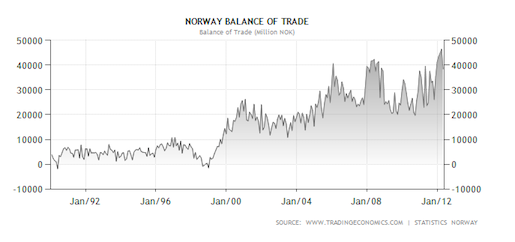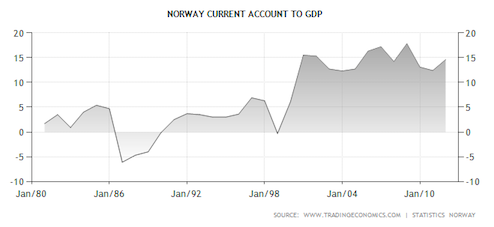Last Friday I wrote a post discussing the risks presented by a slowdown in foreign investment due to the macro-economic structure of the Australian economy. I finished that article with the statement:
So why is this so important? Well, what you may have realised from the above is that it isn’t so much the mining resources, but the initial capital investment that has been supporting Australian economic growth. The growing foreign capital inflows have provided increased national incomes and allowed the economy to continue to grow even though our foreign liabilities have also been increasing. That is, Australians on the whole haven’t been getting wealthier directly from mining, but from the services that mining requires in its initial expansion phase.
As this phase ends the capital inflows from mining will slow which in turn will begin to decrease national income. Without some adjustments in the current account, which as I explained above is structurally difficult given the ownership of the major tradable sectors, Australia is likely heading for period of economic stress.
The point of this post was to clear up some confusion about the Australian economy and to emphasise that its structure is somewhat different to that of many other resource rich nations. Although Australia continues to grow economically we do so by using foreign capital investment to support our standard of living and, by doing so, continue to have a growing national liability to the rest of the world. In this regard Australia is unique in terms of resource rich countries, although Canada does share some of these traits, and again I think this fact causes some confusion.
I’m not going to comment directly on these recommendations, I think some of them are valid, others not so much, but the one that stuck out to me was the sovereign wealth fund. This is a topic that is discussed from time-to-time on MacroBusiness usually in the context of exchange rates and I think it requires some further discussion because it does appear to be a point of confusion for many people.
Sovereign wealth funds tend to be run by national governments of countries that have large current account surpluses which in turn create large government sector surpluses. The basic idea is that instead of releasing the funds into the economy immediately and possibly driving up unwanted consumption the money is saved for a time when the business cycle turns or to fund future generational commitments. The way in which this is done differs from country to country but the basic idea is that the funds purchases assets, usually foreign, and by doing so diversify these savings as well as creating a mechanism of currency control.
Countries that run these funds tend to be resource rich, such as Norway, Russia, Chile, Kuwait and Canada and the major reason is because there economies do , or have the potential to, run large surpluses which they wish to save.
As a point of demonstration here are two charts of Norway’s balance of trade and current account:
And now here is Australia:
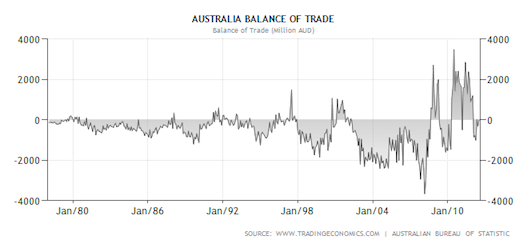
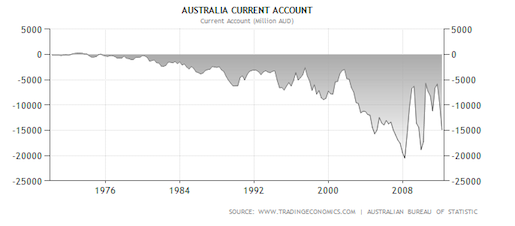
You may have noticed a slight difference, and that is the point. The structure of the Australian economy is unlike that of other resource rich countries. We simply are not Norway, or Russia, or even Canada for that matter. The fact is at present Australia doesn’t have a current account surplus to recycle and therefore the only way Australia could create a sovereign wealth fund without lowering standards of living is by firstly re-directing existing wealth into a fund, by selling off a national asset for example, or indebting the country further. Obviously neither of these solve the issue at hand.
I do believe that some of this confusion is caused by the government’s future fund which in the past I have heard called a sovereign wealth fund. This particular fund was set up to meet the Federal government’s future superannuation liability and was created using funds from the sell-off of Telstra along with payments via surpluses during the Costello/Howard years.
This brings me to statement made by Martin Parkinson yesterday:
Federal Treasury Secretary Martin Parkinson has warned the days of large budget surpluses and buoyant taxation revenue have gone forever.
In a sombre assessment of the global economy that could have implications for the Gillard government’s attempts to return the budget to surplus this financial year, Dr Parkinson said he expected global volatility not seen since the mid-1970s to continue for the next decade.
Although Australia was well-placed to deal with any global shocks, the uncertain international environment would have flow-on effects to the national economy, especially on the federal budget, Dr Parkinson said.
The Treasury boss said the large tax revenue enjoyed during the last resources boom in the mid-2000s was a “temporary bubble in the economy” and was not coming back.
As I’ve explained before , it was private sector credit growth and the associated asset price appreciation that gave the first mining boom the appearance of prosperity and this is the thing that is absent from mining boom II. The growth in private sector credit is how the Howard/Costello government managed to have surpluses in the absence of a positive current account.
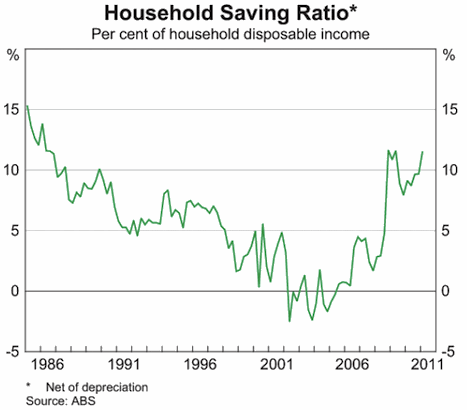
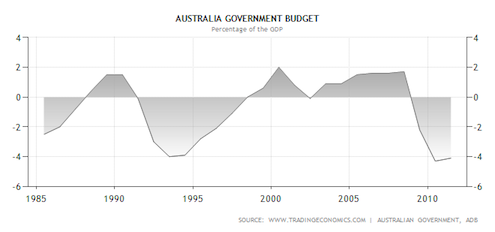
So as you can see the future fund was build, in part, due to the growing indebtedness of the private sector and had nothing to do with managing sovereign wealth that is relevant to a SWF. What you will notice, in fact , is that the balance of trade has been positive for much of the time after the Howard/Costello government was out of power, but this hasn’t translated into government surpluses because the private sector has changed its economic patterns in the wake of the GFC.
It seems that Treasury may be finally catching up to MB and is now highlighting the fact that this is a structural shift in the economy which the government appears unprepared for. As I mentioned in my previous post, and highlighted above, Australia is highly dependent on the continuation of foreign capital in order to maintain economic growth and that presents a serious risk to the economy due to the single dependency on China.
I do, however, agree with Gillard’s task force that changes need to be made in order to protect Australia’s future for a time when the resource boom has faded, however without significant changes in Australia’s economic structure a sovereign wealth fund simply isn’t something we have in our tool belt.
